Use 'Print preview' to check the number of pages and printer settings.
Print functionality varies between browsers.
Printable page generated Sunday, 5 May 2024, 5:35 AM
Study Session 8 Pollution: Effects, Prevention and Control
Introduction
Study Session 7 introduced you to some of the main sources and types of pollution. In this study session you will learn about the effects of pollution on the environment and on human health. You will find out how some pollutants can lead to unexpected problems because of the way they behave and their persistence in the environment. You will also learn about the different ways that people are exposed to pollution. Finally we consider some important principles that underpin the prevention and control of pollution.
Learning Outcomes for Study Session 8
When you have studied this session, you should be able to:
8.1 Define and use correctly all of the key words printed in bold. (SAQs 8.1, 8.2, 8.4 and 8.5)
8.2 Describe the effects of water pollution on aquatic ecosystems. (SAQ 8.2)
8.3 Describe the effects of air pollution on the environment and on human health. (SAQ 8.3)
8.4 Describe the effects of water pollution on human health. (SAQ 8.4)
8.5 Describe some key principles that support pollution prevention and control. (SAQ 8.5)
8.1 Effects of water pollution on the environment
This study session begins by describing the effect of water pollution on surface water ecosystems, such as lakes, rivers and streams. Pollution from human activities enters surface waters, either directly when wastes are dumped into lakes and rivers, or indirectly when wastes released on land or into the air are washed into surface waters.
An ecosystem was defined in Study Session 1 as ‘all living organisms and their physical environment and the interactions between them’. Pollution can disturb and unbalance those interactions in a number of ways.
8.1.1 Effects of organic pollution
You will remember from Study Session 7 that organic matter is any material derived from living organisms. Organic pollution is any contamination of water by organic matter. Examples include human and animal wastes and urban run-off.
Many aquatic (water-living) organisms depend on oxygen dissolved in the water to survive. Aquatic animals include fish, amphibians (e.g. frogs, toads) and many invertebrate species such as insect larvae, snails and worms. Their supply of oxygen in the water is maintained from atmospheric oxygen in the air above the water and from oxygen produced by green aquatic plants in the process of photosynthesis. Fast-flowing, turbulent water will be aerated (gain oxygen) more than still water because the boundary between air and water is more active.
If organic pollutants such as human and animal wastes are released into a water body, bacteria will use the waste as food. Bacteria break down the complex organic chemicals (proteins, fats, carbohydrates) into simpler chemicals that are further oxidised into nitrates, sulphates and carbonates. This process, known as biodegradation, provides energy to the bacteria and uses dissolved oxygen from the water.
If the quantity of organic matter is small and there is plenty of dissolved oxygen, then this natural breakdown process will remove the pollution quite quickly. However, if there are high levels of organic pollution, the population of bacteria increases and may use up all the oxygen from the water. This is called deoxygenation. Complete deoxygenation is unlikely in a river where the water is moving, but it can happen in lakes or slow-flowing channels. Anaerobic (without oxygen) conditions are unsightly and cause unpleasant odours. Fish and other aquatic organisms that need oxygen to survive will eventually die if they cannot migrate elsewhere (Figure 8.1). The reduction in fish populations and other aquatic animals not only disrupts the ecosystem but also results in a loss of food for local people and loss of jobs for local fishermen.
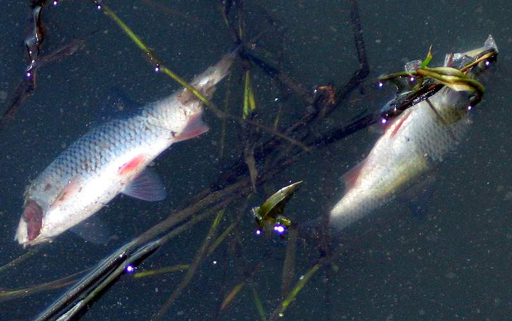
8.1.2 Effects of excess nutrients on the environment
Phosphorus and nitrogen are common pollutants generated from residential areas and agricultural run-off. They are usually associated with human and animal wastes and/or fertiliser. Nitrogen and phosphorus are plant nutrients that plants need in order to grow. If there are large quantities of nutrients, they can encourage excess plant growth in the water. This can cause the phenomenon known as an algal bloom, which means a sudden increase in the population of microscopic algae. If a water body has high nutrient levels it is said to be eutrophic; the process is called eutrophication. Eutrophication is a common phenomenon in Ethiopia and has been observed in Lake Alemaya, Lake Boye, Lake Aba Samuel and Lake Koka (Figure 8.2).
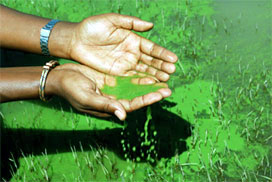
The density of microscopic green algae, as shown in Figure 8.2, blocks sunlight from penetrating the water causing larger plants under the surface to die and decompose. The main problem of eutrophication is that the sudden algal bloom can die off equally quickly. The decay of the algae by bacteria can cause deoxygenation of the water.
Water that contains large amounts of nitrates is unpleasant to drink and can be toxic to humans and animals. Also, some species of cyanobacteria (also known as blue-green algae) that flourish under these conditions produce toxins that cause liver, nerve and skin problems in humans and animals. Toxic levels of cyanobacteria have been found in several Ethiopian lakes (Mankiewicz-Boczek et al., 2015; Willén et al., 2011).
Eutrophication also encourages the growth of larger plants, such as the floating and invasive water hyacinth (Eichhornia crassipes) which can cover large areas of lakes (Figure 8.3). When these plants die, they add to the problems of deoxygenation caused by decaying organic material.
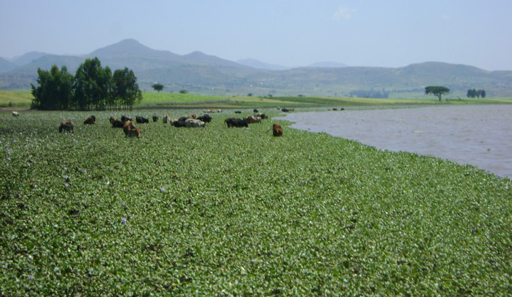
8.1.3 Effects of persistent pollutants
Persistent pollutants, such as heavy metals and persistent organic pollutants (POPs), were mentioned in Study Session 7.
Why are persistent pollutants a major environmental problem?
Persistent pollutants are a major problem because they do not break down by natural degradation processes and therefore remain in the environment for a very long time.
These pollutants may be present at very low concentrations in water but, over time, they build up in the tissues of organisms by a process called bioaccumulation. These chemicals have no known biological function in animals and there is no process to expel them from the body. If the chemicals are ingested or otherwise absorbed from the environment, they remain in the body and gradually accumulate. This is a particular problem for fish and shellfish that feed by filtering plankton from very large volumes of water. If the plankton are contaminated, this will pass into the fish. The pollutants become more and more concentrated and can reach toxic levels.
Figure 8.4 shows how levels of heavy metals, in this case mercury, increase through a food chain. A food chain is the sequence of who eats whom, or what. In Figure 8.4 you can see that the concentration of mercury in water is very low, but increases in the bodies of phytoplankton (small aquatic plants), then in zooplankton (small aquatic animals) as they eat the phytoplankton, and then in the bodies of fish that eat the zooplankton and finally in fish-eating birds. The chemicals can also be passed on to eggs and damage reproduction of the birds. This gradual increase in concentrations through the levels of a food chain is a form of bioaccumulation called biomagnification.
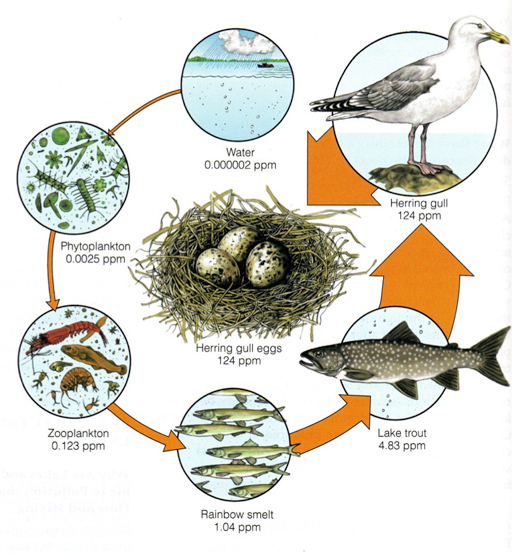
The aquatic food chain extends to terrestrial (land-living) animals and humans. The amount of a pollutant such as mercury can reach a level dangerous enough to cause harm if consumed. Mekuyie (2014) analysed the levels of heavy metals in milk from cows that had drunk water from lagoons that contained wastewater from a textiles factory in Hawassa. The milk contained unsafe levels of heavy metals. The study concluded that this could have toxic effects on people who drank the milk, as well as decreasing livestock productivity and causing damage to the aquatic ecosystem.
Pollutants will continue to bioaccumulate in plants and animals as long as the pollution continues. The Hawassa example demonstrates that some pollutants do not go anywhere, but instead become a part of our life system in the environment.
8.2 Effects of air pollution on the environment
Air pollution is the presence of pollutants in air in quantities that can cause health damage to humans, animals, and plants. When gases such as nitrogen oxides, hydrogen sulphides and sulphur oxides are released into the atmosphere they can dissolve in the water vapour of clouds and fall as rain. The presence of these pollutants acidifies the water and causes acid rain (Figure 8.5).
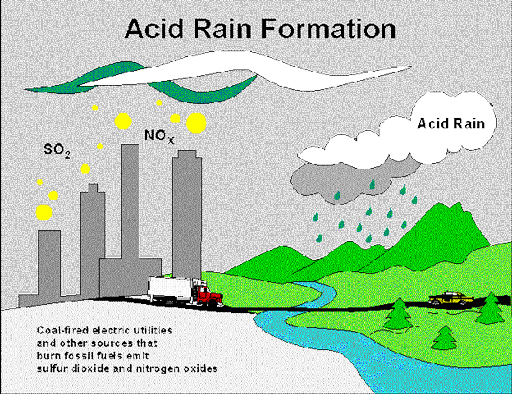
Acid rain usually has a pH of less than 5 and is highly corrosive and damaging, especially to buildings and forests (Figure 8.6). (pH is a measure of acidity and alkalinity on a scale from 0 to 14. pH 7 is neutral; less than 7 is acid; more than 7 is alkaline.)

8.3 Effects of pollution on human health
Most of this section will focus on the effects of water pollution, but we should not forget air pollution. Air pollutants in the form of dust and soot (particulate matter) and gases such as carbon monoxide, sulphur dioxides and nitrogen oxides have serious impacts on health. Intense air pollution causes reduced lung function and diseases of the respiratory system such as asthma and bronchitis. Acute respiratory infections are among the leading causes of attendance at outpatient clinics in health centres and hospitals in Addis Ababa (Tiwari, 2012). The direct causal link is difficult to prove, but air pollution from domestic fires and vehicle emissions is a likely contributory factor. We now turn to the significant impacts on health from water pollution.
8.3.1 Waterborne diseases
On average, every child in Ethiopia has diarrhoea five times before the age of five. What could be the cause of these illnesses in children? What other factors might have been involved in transmitting these illnesses?
Ingesting contaminated water and food is the cause of diarrhoea. Poor hand hygiene is also a significant factor in its transmission.
Diarrhoea (frequent loose stools) is a symptom of many waterborne diseases. They are caused by biological pollution from human bodily wastes from infected people. Faecal matter contains pathogenic organisms that cause waterborne diseases, mainly diarrhoeal diseases and parasitic worm infections. Some examples of diarrhoeal and other waterborne diseases and their causes are shown in Table 8.1.
| Group | Disease | Causative agent |
| Bacteria | typhoid fever | Salmonella |
| cholera | Vibrio cholerae | |
| Viruses | viral gastroenteritis | rotavirus and others |
| poliomyelitis | polio virus | |
| viral hepatitis | hepatitis A and E virus | |
| Protozoa | cryptosporidiosis | Cryptosporidium |
| giardiasis | Giardia | |
| Parasitic worms | ascariasis | Ascaris lumbricoides |
| schistosomiasis or bilharzia | Schistosoma |
With one exception, all the diseases in Table 8.1 are caused by people ingesting pathogens by drinking or eating contaminated water or food, or they result from poor hand hygiene. This is faecal–oral transmission which means people are infected with disease when pathogens from faeces enter their body through the mouth. The exception is schistosomiasis, which is caused by worms penetrating the skin when people are swimming or washing in water that has been contaminated with excreta from an infected person.
8.3.2 Chronic health effects of water pollution
Humans are susceptible to the chronic health effects of chemical pollutants if they regularly consume contaminated water or food, especially by eating fish that have lived in polluted water. The process of bioaccumulation can lead to toxic levels of pollutants in fish which, when eaten, lead to damaging levels of toxins in humans. We will illustrate this effect using a historical event that took place in Japan.
Case Study 8.1 Minamata Bay, Japan, 1951
Japan was recovering from an economic crisis in the 1940s after being defeated in the Second World War and was expanding its chemical industries. The Chisso Chemical Corporation had been operating in Minamata since 1932, but had introduced a new manufacturing process using inorganic mercury in 1951. The mercury was released into the sea with wastewater at nearby Minamata Bay. The inorganic mercury was biodegraded and changed into organic mercury, a form that was readily absorbed by fish. Biomagnification of the organic mercury took place in the food chain and led to very high concentrations in the bodies of fish and shellfish.
These fish and shellfish were eaten by the local Japanese people as part of their normal diet. Public complaints started in 1956 as serious damage to people’s health started to be seen. People had symptoms indicating damage to the nervous system (Figure 8.7). There was also damage to the sea environment and other animals such as pigs, cats, dogs and birds that ate contaminated fish. Early studies in 1956 made the link to consumption of fish by victims and suggested the cause was heavy metal contamination (Hachiya, 2006). Factory waste from the Chisso Corporation was suspected but it was difficult to prove. The government and the factory denied the pollution was due to mercury discharges for many years and mercury continued to be released into the environment. It was not until 1968 that the government officially recognised that the cause of ‘Minamata disease’ was mercury poisoning. It took 12 years and many protests and lawsuits before the pollution was stopped. By 2001, of the 2955 victims who had been officially certified and paid compensation, many had died (Ministry of Environment, 2002), although many thousands more had been affected (Hachiya, 2006).

(Adapted from Cunningham and Cunningham, 2011)
What can we learn from the Minamata story? Although the source was suspected, it still took 12 years before it was recognised. The government and the company denied responsibility and we may suspect a political and economic motive for their refusal to recognise the problem for more than ten years, despite the evidence. We can also see that pollutants can enter the human body through complex routes. The mercury changed its form after it was released into the bay, making it harder to trace. It was not put straight into human food but entered it by bioaccumulation through the food chain from micro-organisms, through small fish to bigger fish.
Another important point from this example is whether the generator of waste is responsible for the waste that they produce, the pollution that they cause in the environment and for the harm caused by that pollution. In this example, the pollution was traced back to the polluter and compensatory payment was made. However, it took a long time and some think that payment was not adequate for the damage caused.
8.4 Human exposure to pollution
Exposure is the state of being unprotected. It is a set of conditions that allows a pollutant or contaminant to enter the human body. The presence of pollution, the medium that the pollutant is in and the human subject or host that will be affected by the pollutant are the set of conditions used to describe the exposure. In the Minamata example, the source was the Chisso factory, the medium was the water and the subjects were the people who consumed contaminated fish.
There are three main routes by which people are exposed to pollution. These are:
- Ingestion: in the Minamata example people ingested contaminated fish.
- Inhalation: repeatedly breathing in air pollutants can cause respiratory diseases.
- Skin contact (also called dermal exposure): direct contact, usually with the hand, in which chemicals penetrate the skin and enter the circulatory system.
Figure 8.8 indicates the possible exposure routes for pollutants and links from source to recipient.
8.5 Preventing and controlling pollution
In this final section we look at some important principles that should be applied when attempting to prevent or control pollution. Pollution prevention means avoiding or minimising the generation of wastes that produce pollutants, thereby restricting their release into the environment. Pollution control focuses on measures taken after wastes have been produced to limit the damage they may cause. It is often more difficult and expensive to control pollution after it has been released into the environment.
Which do you think is better - pollution prevention or pollution control?
Pollution prevention is better. It is better to try and prevent pollution from being created in the first place and it is more difficult and expensive to control pollution after it has been created. However, if pollution has been created, it should be controlled.
8.5.1 Prevention
There are many methods for prevention of pollution. For water pollution the main priority is to improve water, sanitation and hygiene (WASH) provision. If everyone has access to effective sanitation (latrines) and there is no open defecation, this will prevent contamination of the environment with human faeces. Combined with this is the need for safe drinking water to be available for all. In addition, improving hygiene behaviour and ensuring that everyone washes their hands will radically reduce the impacts on human health from biological pollutants. In practice there needs to be a coordinated approach to improving all three – water, sanitation and hygiene – which is reflected in current WASH programmes.
Air pollution can be improved by reducing the reliance on biomass fuels for domestic cooking, especially for indoor fires. Legislation to remove very old vehicles from the road or a requirement for regular maintenance and certification would also help.
For pollutants derived from solid wastes, waste optimisation should be adopted. This principle is based on the notion that, ideally, waste should not be produced in the first place. However, this primary target is not always possible and so, if waste is produced, there is a range of options for waste management that form a waste hierarchy from most desirable to least desirable (Figure 8.9).
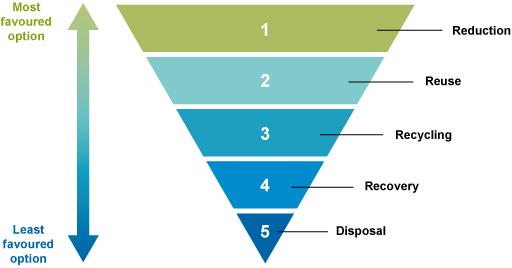
The waste optimisation principle includes the application of what is known as the ‘3 Rs’ – reduce, reuse and recycle. Reduction refers to the minimisation of waste at source by efficient use of raw materials and changing the technology for producing items. Reuse means using an item more than once, for example, the use of plastic bottles for collecting water. Recycling refers to the use of discarded materials as raw materials that are taken back into the factory process. The use of discarded and broken bottles in a glass factory to make new glass bottles is an example of recycling. The waste hierarchy also includes recovery of materials or energy, for example through composting or incineration. Composting is a good example of recovering materials from waste organic matter that can be then used to improve soil in a constructive way rather than allowing the decomposition process to cause pollution by careless disposal.
The concept of waste optimisation is applied in industries through the process of cleaner production. Cleaner production aims to reduce the impact of industry on the environment through waste minimisation and the application of the 3 Rs, and other processes such as replacement of toxic chemicals with less toxic alternatives, and process and product modification to use less energy.
8.5.2 Principles for pollution control
The following principles are used to help control pollution.
Polluter pays principle
The polluter pays principle says that whoever is responsible for pollution should pay for the damage caused. It is about economic accountability. Any organisation or individual is responsible for handling and taking care of the waste they produce and should be accountable for any damage that it causes. Imagine a factory that produces many types of wastes that potentially damage the air, water and soil. The polluter pays principle encourages the factory to treat the waste before it is released. If any damage to the environment is caused by the factory waste, then the factory is liable to compensate for the loss of life, damage to health and damage to property and the environment.
Precautionary principle
For any activity, there should be an obligation not to cause harm, even if you are not sure of the outcome. For example, if a factory owner wants to discharge wastewater into a river, they should not be allowed to do so if the possible effects of the wastes are not known. The precautionary principle means you do not release any waste into the environment even if you are not certain that damage will result. It means to be cautious rather than take risks about unknown consequences.
Principle of duty of care
Article 44 of The Constitution of Ethiopia provides a guarantee that citizens have the right to live in a clean and healthy environment. But how can this be achieved? All citizens should be actively involved in safeguarding their environment, either by not producing any waste or by properly handling and taking care of their own waste. In other words, each citizen has an obligation or duty to make their environment clean and safe.
8.5.3 Policies and proclamations
In Ethiopia there are several policies, strategies, proclamations and regulations that apply to different aspects of pollution prevention and control. These include the Environmental Policy of Ethiopia (1997) which promotes the use of renewable resources and recycling, and includes specific policies for industrial waste among other environmental sectors. The Prevention of Industrial Pollution Regulation (2008) requires any establishment, institution or factory to obtain a permit to discharge its waste into the nearby environment. The Solid Waste Management Proclamation (2007) sets out the responsibilities of urban administrations to provide solid waste management services. These and other national policies are described in Study Session 15.
Summary of Study Session 8
In Study Session 8, you have learned that:
- Biodegradation of organic matter removes oxygen from the water and can lead to deoxygenation with consequent harm to fish and other aquatic life.
- High nutrient levels in water is called eutrophication. This process causes increasing density of algae and other plants which can reduce penetration of light into the water and cause deoxygenation when the plants die and decay.
- Bioaccumulation is the gradual build-up of chemicals in the bodies of living organisms. Increasing accumulation through the levels of a food chain is called biomagnification. Eating food such as fish containing bioaccumulated chemicals will damage human health.
- Humans are exposed to pollutants by ingestion with water and food, inhalation through breathing and absorption through the skin.
- Pollution prevention means avoiding or minimising the production of wastes before they are released into the environment. Pollution control involves measures to limit the damage caused by pollutants.
- Pollution control is supported by principles such as the polluter pays principle, the precautionary principle and the principle of duty of care, and by relevant legislation and policies.
Self-Assessment Questions (SAQs) for Study Session 8
Now that you have completed this study session, you can assess how well you have achieved its Learning Outcomes by answering the following questions.
SAQ 8.1 (tests Learning Outcome 8.1)
Define the words biodegradation, bioaccumulation and biomagnification, and explain the difference between them.
Answer
Degradation means ‘breaking down’, and biodegradation means the breaking down of complex substances into simpler substances by biological processes, mostly the action of bacteria. Accumulation means ‘build-up’, and bioaccumulation is the gradual build-up or increase of persistent pollutants in the body of individual animals as they eat contaminated food. Magnify means ‘to enlarge’ and biomagnification is the gradual increase of pollutants in the bodies of different organisms linked by a food chain.
So, all these processes involve living organisms (biological processes), but the first involves the breaking down of complex substances, the second involves build-up of persistent pollutants in an organism and the third involves the increase of pollutants up the food chain.
SAQ 8.2 (tests Learning Outcomes 8.1 and 8.2)
Nutrients such as nitrogen and phosphorus are useful to farmers who apply them to fields to help increase growth of their crops. Write a paragraph that explains how these same nutrients cause pollution when they are washed off into rivers and lakes. Your answer must include the following words: algal bloom; deoxygenation; eutrophic; fish; organic matter.
Answer
Your answer will not be exactly the same; this is one possible answer.
When nitrogen and phosphorus are washed into a river or lake, the water becomes eutrophic, meaning that it has high levels of plant nutrients. This will cause excess plant growth and may produce a sudden increase in microscopic algae called an algal bloom. When the plants die, the dead plant material adds to the organic matter in the water. Decomposition of the organic matter can result in deoxygenation of the water, which will kill fish.
SAQ 8.3 (tests Learning Outcome 8.3)
Give three examples of air pollutants, three examples of sources of air pollution and three possible effects of air pollution on human health.
Answer
You may have chosen any of the following:
Examples of air pollutants: dust, soot, particulates, nitrogen oxides, sulphur dioxide, carbon monoxide.
Sources: domestic fires, vehicle emissions, industrial chimneys.
Effects on human health: reduced lung function (difficulty with breathing), asthma, bronchitis.
SAQ 8.4 (tests Learning Outcomes 8.1 and 8.4)
- a.Complete all the gaps in the table below.
| Water pollutant | Exposure route | Human health effect |
| Vibrio cholerae bacteria | ||
| schistosomiasis/bilharzia | ||
| organic mercury | ingestion | |
| ascariasis |
- b.Which of the diseases in your completed table are transmitted by faecal-oral transmission?
Answer
- a.The answers are as follows:
| Water pollutant | Exposure route | Human health effect |
| Vibrio cholerae bacteria | ingestion | cholera |
| Schistosoma worm | skin contact | schistosomiasis/bilharzia |
| organic mercury | ingestion | Minamata disease |
| Ascaris worm | ingestion | ascariasis |
- b.Cholera and ascariasis are both transmitted by the faecal-oral route. People become infected with these diseases when they drink water or eat food that is contaminated with faecal matter from infected individuals.
SAQ 8.5 (tests Learning Outcomes 8.1 and 8.5)
A junior manager in a manufacturing company is asked to write a report to the Chief Executive with recommendations for reducing the environmental impact of their factory. Rewrite this extract from the report using terms from the list provided to fill the gaps:
cleaner production; pollution prevention; precautionary principle; polluter pays principle; recycling; reduce; reuse; waste hierarchy; waste minimisation.
Our company has a duty to reduce pollution from the wastes produced in our factory. We should adopt policies of ………………, which avoid pollution in the first place. I recommend that we follow the ……………… and do not assume that our wastes will not cause any environmental damage. We should adopt ……………… processes to ensure we reduce our impact on the environment.
For management of the solid wastes produced in our factory we should follow the ……………… This means we should first ……………… the amount of waste produced and identify opportunities for ……………… and ……………… If we successfully adopt these ……………… procedures we will reduce potential pollution from our company. Although some costs may be incurred, this could save money in the long run because under the ……………… we may be liable for costs of any environmental damage that we cause.
Answer
Our company has a duty to reduce pollution from the wastes produced in our factory. We should adopt policies of pollution prevention, which avoid pollution in the first place. I recommend that we follow the precautionary principle and do not assume that our wastes will not cause any environmental damage. We should adopt cleaner production processes to ensure we reduce our impact on the environment.
For management of the solid wastes produced in our factory we should follow the waste hierarchy. This means we should first reduce the amount of waste produced and identify opportunities for reuse and recycling. If we successfully adopt these waste minimisation procedures we will reduce potential pollution from our company. Although some costs may be incurred, this could save money in the long run because under the polluter pays principle we may be liable for costs of any environmental damage that we cause.
